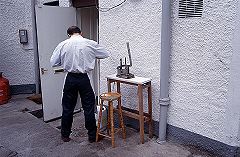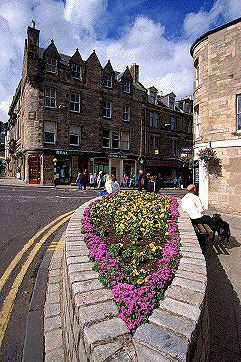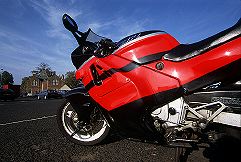Sigma 18-35mm f3.5-4.5 AF Aspherical zoom
A brief appraisal
This article by David Kilpatrick is based on one scheduled to appear in Photo Club News No 2, publication February 1995
The wide-angle focal lengths of 18mm, 24mm, 28mm and 35mm
are more than just useful, and the apparently small steps between them are deceptive. Unlike long focus lenses, wide-angles are used at distances where 'human scale' changes in the camera position alter composition, visual perspective and subject scale dramatically.
Try this experiment. Get a chair and ask a member of your camera club to stand next to it. Fit a 24mm lens to your camera. Demonstrate how, by taking only one step sideways either way, ducking down, or standing on the chair, you can view your subject from almost every possible angle. Now get a 135mm tele, fit it to a camera, and challenge anyone to tell you how deep a pit, how many paces to each side, and how tall a ladder they would need to repeat the exercise!
 That's why press-men love wide-angle zooms. Lean to the side, and you change the background. Kneel, and the skies open up. Step forward and zoom to 35mm - you have a frame-filling portrait. Blend back into the rat-pack, zoom to 18mm and your subjects are there full-length, in action, even if there's a whole crowd of them.
That's why press-men love wide-angle zooms. Lean to the side, and you change the background. Kneel, and the skies open up. Step forward and zoom to 35mm - you have a frame-filling portrait. Blend back into the rat-pack, zoom to 18mm and your subjects are there full-length, in action, even if there's a whole crowd of them.
Right: behind the chip-shop - quick composition zoomed to around 24-28mm
Sigma's 18-35mm Aspherical AF zoom is streets ahead of their earlier 21-35mm. My trials were not so much of its uses as outlined above as to see whether it can keep lines straight for architectural photography and produce a sharp, evenly-lit picture.
 The reproductions should speak for themselves. The lens can suffer from low contrast and some flare in adverse light, and would benefit from an 81a filter (it runs fairly cool). It's very light, focuses rapidly and positively, and is free from any obvious vices like vignetting or pincushion distortion. Its fractional degree of barrelling is entirely acceptable and easily compensated for in most compositions.
The reproductions should speak for themselves. The lens can suffer from low contrast and some flare in adverse light, and would benefit from an 81a filter (it runs fairly cool). It's very light, focuses rapidly and positively, and is free from any obvious vices like vignetting or pincushion distortion. Its fractional degree of barrelling is entirely acceptable and easily compensated for in most compositions.
Left: illumination and sharpness are excellent, as of course is depth of field at f22. Wide-angles help you use foregrounds and exploit shapes. The actual scale of this tapered flower-bed in the Scottish Border town of Jedburgh is far smaller than its relationship to the buildings would suggest.
If you read test reports criticising it for curved geometry, that will be because some wally assessed it focused on a test chart at arm's length. (This report was shown to the UK distributors in early October 1994, and we note with amusement that a lengthy disclaimer of such wallydom appeared in the first amateur press review to be printed, about a month later - Ed) Use it on subjects from 3m to infinity, and the critical 18mm setting will give near-perfect straight lines right to the very edge of the frame (see living-room interior example, especially right-hand window detail).

The lens costs over �400 but can certainly justify its price on performance. I tested it on a Minolta 700si body with Fujichrome Provia 100 slide film.
Left: interior, hand-held, natural light at f3.5, 18mm - geometrically spot-on.

Right: a very close, very low viewpoint at 18mm hides dozens of parked vehicles.
 That's why press-men love wide-angle zooms. Lean to the side, and you change the background. Kneel, and the skies open up. Step forward and zoom to 35mm - you have a frame-filling portrait. Blend back into the rat-pack, zoom to 18mm and your subjects are there full-length, in action, even if there's a whole crowd of them.
That's why press-men love wide-angle zooms. Lean to the side, and you change the background. Kneel, and the skies open up. Step forward and zoom to 35mm - you have a frame-filling portrait. Blend back into the rat-pack, zoom to 18mm and your subjects are there full-length, in action, even if there's a whole crowd of them. The reproductions should speak for themselves. The lens can suffer from low contrast and some flare in adverse light, and would benefit from an 81a filter (it runs fairly cool). It's very light, focuses rapidly and positively, and is free from any obvious vices like vignetting or pincushion distortion. Its fractional degree of barrelling is entirely acceptable and easily compensated for in most compositions.
The reproductions should speak for themselves. The lens can suffer from low contrast and some flare in adverse light, and would benefit from an 81a filter (it runs fairly cool). It's very light, focuses rapidly and positively, and is free from any obvious vices like vignetting or pincushion distortion. Its fractional degree of barrelling is entirely acceptable and easily compensated for in most compositions.
